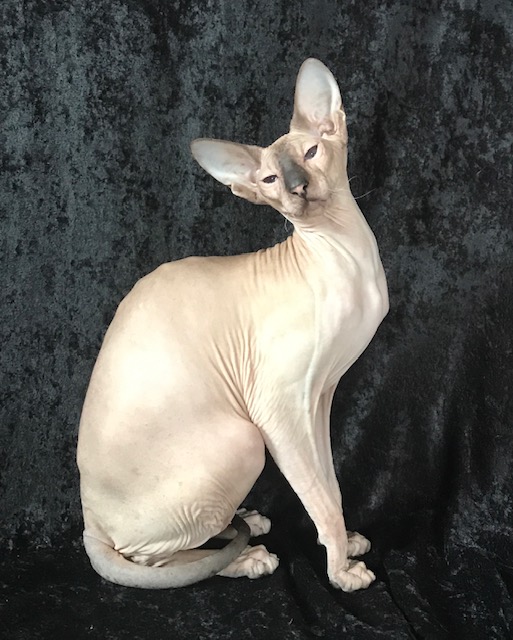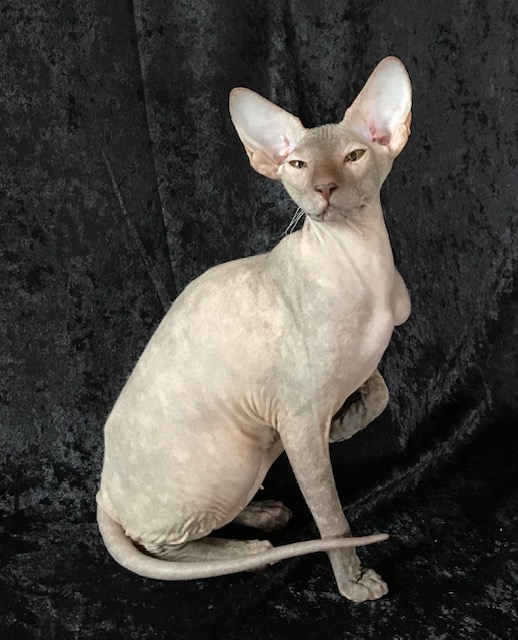Taken from Tica.org
The Peterbald Breed at a Glance
Peterbalds are an uncommon, yet highly sought after breed. Their coats come in a wide variety that ranges from completely bald to a full coat. Extremely loyal and one of the most social breeds, they are an ideal breed for families or those with a small home. Their sweet temper and curious nature has captured the hearts of cat lovers across the world. Find out if this breed is right for you and your family.
- Temperament: Loyal, Interactive, Intelligent
- Height/Weight Range: Medium-sized
- Kittens: 2-3 pounds when ready to leave for new homes at 12-16 weeks
- Adult females: 5-7 pounds
- Adult males: 7-10 pounds
- Colors: Peterbalds are available in all colors as well as pointed (pale body and relatively darker extremities, i.e. the face, ears, feet, tail and in males, scrotum).
- Hair Type: Contrary to its name, the Peterbald comes in five coat variations, including: Completely hairless or very fine short hair on the face and extremities, A coat that resembles a peach or a piece of suede, Varying coat lengths, made entirely of downy soft hair without waves, curling or gloss, A coat made up of varying lengths made entirely of wiry, kinky hair a man's bristly beard, or it may lack the Peterbald trait and have an ordinary cat coat
- Life Expectancy: 12-15+ years
About the Peterbald
Friendly and fun, the Peterbald breed is an excellent choice for those looking for a cat that enjoys company and attention. Often compared to canines for their level of loyalty, Peterbalds are a very loving, social and affectionate breed. They get along well with other animals (including cats), children and even visitors, so much so that they love playing host to guests. They love to follow their favorite humans around and will even talk to their owners as they are often vocal.
Activity Level:
Peterbald cats are a highly athletic, smart and active breed that tend to move quickly. They travel well and settle down quickly once they are played out. Highly intelligent, they love to be challenged and play fetch for endless amounts of time, but are equally as happy curling up on their owners lap or crawling under the covers with them when they go to bed.
Care
Grooming:
While grooming practices for a Peterbald vary depending on the coat type, none require a lot of grooming.
Hairless should be bathed every other week. Be careful not to wash too often as it could produce oil and become counterproductive. Those with hairless varieties should keep in mind that they are more sensitive to the weather and may need an extra layer in the winter and sunscreen in the summer.
All other coat types should be brushed once a week with a fine-toothed comb to remove dead hair.
Keep their nails trimmed, ears cleaned and teeth brushed regularly with a vet-approved pet toothpaste and provide a nice tall scratching post to help their natural scratching instinct.
Nutrition:
The Peterbald should maintain a slim but muscular body shape in adulthood, so feeding them a well-balanced diet works best. Access to food at all times is ideal as they tend to graze.
As with all cats, it is important to give your cat fresh, clean water daily, so cats don’t hesitate to drink. The water bowl should be placed at least three feet away from any food. Cats’ noses are sensitive and an overwhelming smell of food may cause them to drink less.
Health
To date, no health issues have been reported therefore no screening suggestions have been made. However, it is important to follow nutrition and grooming suggestions to prolong the health and safety of a Peterbald.
History
Peterbalds are a rare and relatively new breed. Discovered in the Russian city of Rostov on Don in 1988, the new breed was celebrated by the Russians as a dominant mutation for bald cats. Originally called the Don Sphynx, cats were soon exported to breeders in Europe. As a result, it was found that some kittens born were hairless while others had a full coat. It was decided that the hairlessness was a genetic mutation. It was later discovered that some (although not all) kittens born with a full coat were sometimes losing their hair as they got older. The ultimate combination of breeding between a Don Sphynx and an oriental shorthair ultimately led to what is now called the Peterbald breed. In 2005 the International Cat Association accepted the Peterbald into championship competition.
Similar Breeds:
Siamese and Oriental breeds
Opposite Breeds:
Persian, Maine Coon and any other long-haired and substantially boned breed.
Did You Know?
The Peterbald’s coat can change. The coat a Peterbald cat is born with does not represent his forever fur. His coat can change during his first two years, with hair texture being either lost or gained.
Lack of fur means higher metabolism. Due to their lack of fur, Peterbalds have a higher metabolism than cats with full coats, requiring that they consume more food than their coated counterparts. That high metabolism also makes them heal faster than coated kitties (who have slower metabolisms) when it comes to scratches and other wounds.
Hairless Peterbalds are not all hypoallergenic. While Peterbald cats are sometimes bald or nearly bald, this does not necessarily mean that you will not have an allergic reaction. Allergies from cats can originate with the saliva, coat, or dander. It is best to spend a significant time around any particular breed before choosing one for your home.
From the Breed Standard
The overall impression of an ideal Peterbald is an elegant and intelligent cat. The Peterbald has a sturdy, long, lean body that contributes to its graceful movement. The first Peterbalds were born in Russia in January, 1994, the result of breeding an Oriental Shorthair (Radma Vom Jagerhof) to a light-boned Oriental- looking Donskoy (Afinoguen Myth). The original litter demonstrated that the Peterbald/Donskoy gene is a dominant gene, unlike the (Canadian) Sphynx gene. Typical of the breed are various unusual coat textures ranging from hairless to full brush coat to normal coat.

